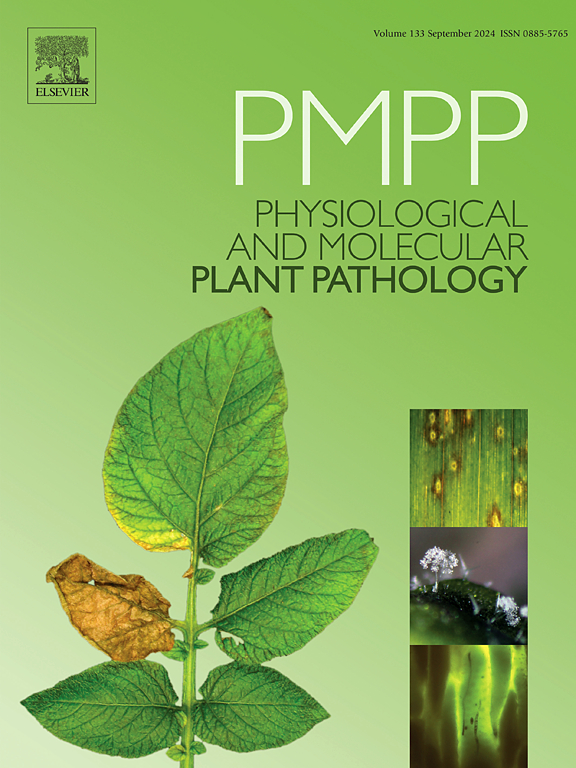吡唑嘧啶对14种病原真菌和3种植物线虫的杀真菌和杀线虫活性
IF 2.8
3区 农林科学
Q2 PLANT SCIENCES
引用次数: 0
摘要
为了发现新的杀菌剂或先导化合物,对几种吡唑并嘧啶类化合物的杀真菌活性进行了评价。结果表明,化合物R13和R14具有最广谱的杀真菌活性。在浓度为50 mg/L时,对13种真菌的生长抑制率达90%以上。其中,化合物R13和R14对dothidea botryosphaia dothidea的EC50值分别为2.3和1.1 mg/L,均优于市售杀菌剂azoxystrobin (18.7 mg/L)。化合物R14不仅破坏了双歧杆菌菌丝的表面形态,还通过破坏细胞膜引起细胞质含量渗漏和膜通透性增加。化合物R7对白僵线虫(Aphelenchoides besseyi)、白僵线虫(Ditylenchus destructor)和木蠹蛾(Bursaphelenchus xylophilus)也有良好的杀线虫活性。因此,吡唑并嘧啶类化合物是开发具有双重杀真菌和杀线虫性能的新型农用化学品的良好材料。本文章由计算机程序翻译,如有差异,请以英文原文为准。

Fungicidal and nematicidal activities of pyrazolopyrimidine against 14 pathogenic fungi and 3 plant nematodes
To discover novel fungicides or lead compounds, the fungicidal activities of some pyrazolopyrimidine compounds were evaluated. The results showed that compounds R13 and R14 exhibited the broadest-spectrum fungicidal activities. At a concentration of 50 mg/L, they showed over 90 % growth inhibition against 13 fungi. In particular, the EC50 values of compounds R13 and R14 against Botryosphaeria dothidea (B. dothidea) were 2.3 and 1.1 mg/L, respectively, both superior to the commercial fungicide azoxystrobin (18.7 mg/L). Compound R14 not only disrupted the surface morphology of B. dothidea hyphae, but also caused cytoplasmic content leakage and increased membrane permeability by damaging the cell membrane. Compound R7 also exhibited excellent nematicidal activities against Aphelenchoides besseyi (A. besseyi), Ditylenchus destructor (D. destructor), and Bursaphelenchus xylophilus (B. xylophilus). Therefore, pyrazolopyrimidine compounds are promising scaffolds for developing novel agrochemicals with dual fungicidal and nematicidal properties.
求助全文
通过发布文献求助,成功后即可免费获取论文全文。
去求助
来源期刊
CiteScore
4.30
自引率
7.40%
发文量
130
审稿时长
38 days
期刊介绍:
Physiological and Molecular Plant Pathology provides an International forum for original research papers, reviews, and commentaries on all aspects of the molecular biology, biochemistry, physiology, histology and cytology, genetics and evolution of plant-microbe interactions.
Papers on all kinds of infective pathogen, including viruses, prokaryotes, fungi, and nematodes, as well as mutualistic organisms such as Rhizobium and mycorrhyzal fungi, are acceptable as long as they have a bearing on the interaction between pathogen and plant.

 求助内容:
求助内容: 应助结果提醒方式:
应助结果提醒方式:


